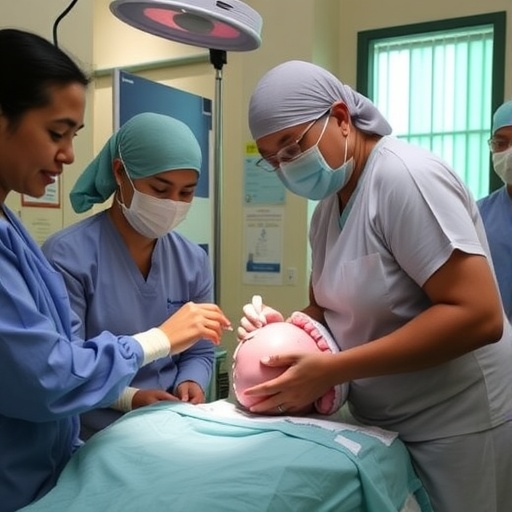In a landmark study spanning over two decades, researchers have illuminated sweeping changes in childbirth care practices in Cambodia, highlighting significant disparities in cesarean section utilization between public and private health facilities. This comprehensive analysis traces the evolution of maternal healthcare from 2000 to 2021, offering a critical lens into how healthcare infrastructure and socioeconomic factors have shaped maternal outcomes in a rapidly developing Southeast Asian nation.
Cambodia’s maternal health landscape has undergone profound transformation due to economic growth, healthcare policy reforms, and increased access to medical services. Despite general improvements in maternal health indicators, the use of cesarean sections—a lifesaving surgical intervention—reveals stark inequities rooted in the dichotomy between public and private healthcare providers. This disparity poses essential questions about healthcare quality, accessibility, and the socio-economic determinants influencing childbirth options.
The study meticulously compiled national data on childbirth modalities for more than two decades, investigating rates of cesarean section delivery in both governmental hospitals and private healthcare centers. The researchers found that while cesarean rates increased overall, the rise was disproportionately higher in private facilities. This divergence underscores the complexity of healthcare delivery dynamics, where market forces, healthcare financing, and provider incentives interplay with clinical decision-making.
Public health infrastructure in Cambodia historically struggled to meet the growing demands for obstetric services, often limited by resource constraints and uneven distribution of skilled medical personnel. Consequently, cesarean sections remained relatively infrequent in public facilities, reserved predominantly for medical necessity. In contrast, private clinics have not only expanded rapidly but also appear to embrace more liberal usage of surgical interventions, raising concerns about potential over-medicalization and the economic motivations driving higher cesarean rates.
The research delved into detailed demographic analyses, illustrating how wealth, geographic location, educational status, and healthcare affordability influence the likelihood of cesarean delivery. Urban residents and wealthier women were significantly more likely to give birth via cesarean in private settings, whereas rural and lower-income populations primarily relied on public hospitals with limited access to surgical childbirth. This disparity flags an urgent need to bridge the healthcare equity gap to ensure safe, evidence-based maternal care for all socioeconomic groups.
Technically, the study employed a multidimensional analytical framework combining quantitative national health surveys, hospital records, and policy review to elucidate trends over time. Advanced statistical modeling was applied to control for confounders such as maternal age, parity, and pregnancy risk factors, isolating the impact of facility type on cesarean utilization. This rigorous methodological approach lent robustness to the findings, reinforcing concerns about disparate healthcare delivery models.
Clinically, the overuse of cesarean sections in private settings carries implications beyond budgetary costs. Unnecessary cesarean deliveries can lead to increased risks including infection, extended recovery periods, and adverse consequences for subsequent pregnancies. Balancing obstetric interventions to align with World Health Organization-recommended cesarean rates is pivotal to optimizing maternal and neonatal outcomes across Cambodia’s health system.
The broader context of this study ties into global conversations about healthcare privatization, maternal health equity, and the ethics of clinical decision-making influenced by financial incentives. Cambodia’s experience mirrors trends observed in other low- and middle-income countries where rapid privatization has reshaped service delivery landscapes but also magnified disparities in care utilization and quality.
Policy implications arising from this research are manifold. There is an urgent need to strengthen regulatory oversight over private healthcare providers to curb non-medically indicated cesarean sections. Efforts to enhance public sector capacity, especially in rural and underserved regions, must be prioritized to provide equitable access to comprehensive childbirth care. Additionally, community education on safe childbirth options and shared decision-making can empower women to navigate their healthcare choices confidently.
Innovative healthcare financing mechanisms, such as social health insurance schemes, may serve to reduce financial barriers to accessing quality obstetric care in public facilities, mitigating the push towards private options driven by affordability perceptions. Strengthening midwifery and obstetric training within the public sector can also help ensure readiness to manage complex deliveries that necessitate surgical intervention.
The study’s longitudinal scope offers a unique vantage point to assess the impact of Cambodia’s evolving healthcare policies on maternal health outcomes. By juxtaposing the private and public healthcare sectors’ trajectories, the research underscores the multifaceted challenges faced by policymakers in achieving universal maternal healthcare coverage that is both equitable and of high quality.
Looking ahead, future research should examine the downstream effects of cesarean section disparities on maternal and neonatal morbidity and mortality in Cambodia. In addition, qualitative studies exploring women’s healthcare preferences, provider motivations, and systemic barriers will complement quantitative findings by adding nuanced understanding of the socio-cultural fabric influencing childbirth care.
As Cambodia continues to reform and expand its healthcare system, balancing the benefits of privatization with the imperatives of equity and evidence-based practice will be critical. This study provides an invaluable evidence base for stakeholders to design interventions that narrow gaps in maternal health services, improve outcomes, and ultimately safeguard the well-being of Cambodian families.
In sum, the thorough investigation into two decades of childbirth care dynamics in Cambodia reveals a health system at a crossroads, where socioeconomic disparities manifest starkly in life-altering clinical decisions. This research encapsulates a global maternal health challenge—how to harness innovation and investment in healthcare delivery without compromising the equitable, safe, and rational use of medical technologies such as cesarean sections.
Subject of Research:
Disparities in cesarean section utilization between public and private healthcare facilities in Cambodia over the period 2000–2021.
Article Title:
Two Decades of Change in Childbirth Care in Cambodia (2000–2021): Disparities in Ceasarean Section Utilization Between Public and Private Facilities.
Article References:
Zhang, Y., Khuon, D., Saphonn, V. et al. Two Decades of Change in Childbirth Care in Cambodia (2000–2021): Disparities in Ceasarean Section Utilization Between Public and Private Facilities. Global Health Research and Policy 10, 32 (2025). https://doi.org/10.1186/s41256-025-00429-7
Image Credits: AI Generated




